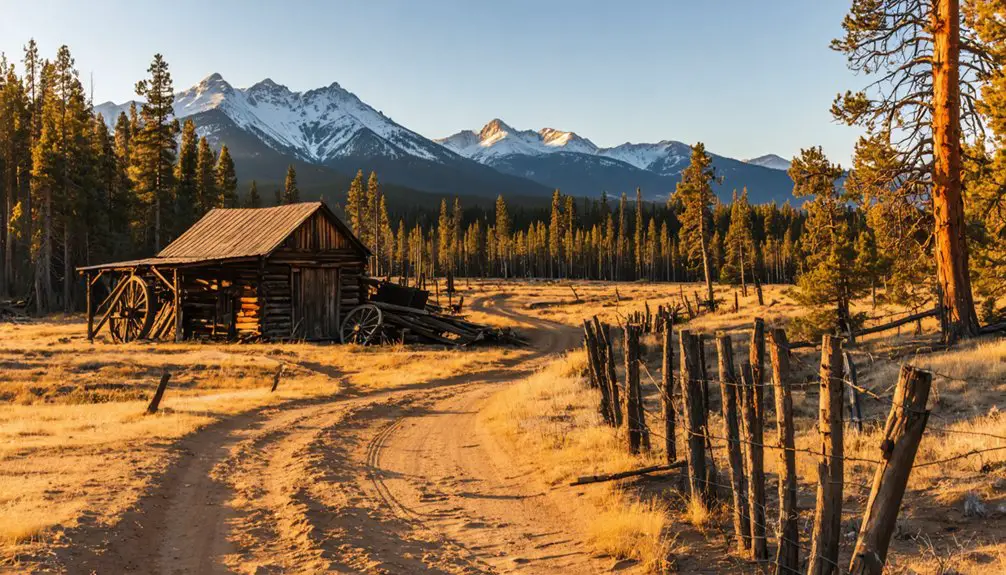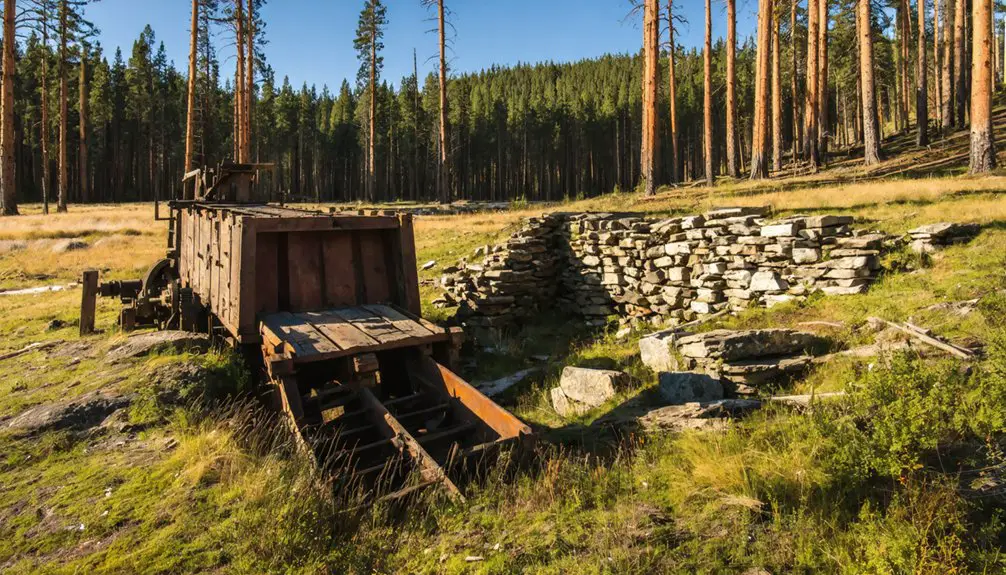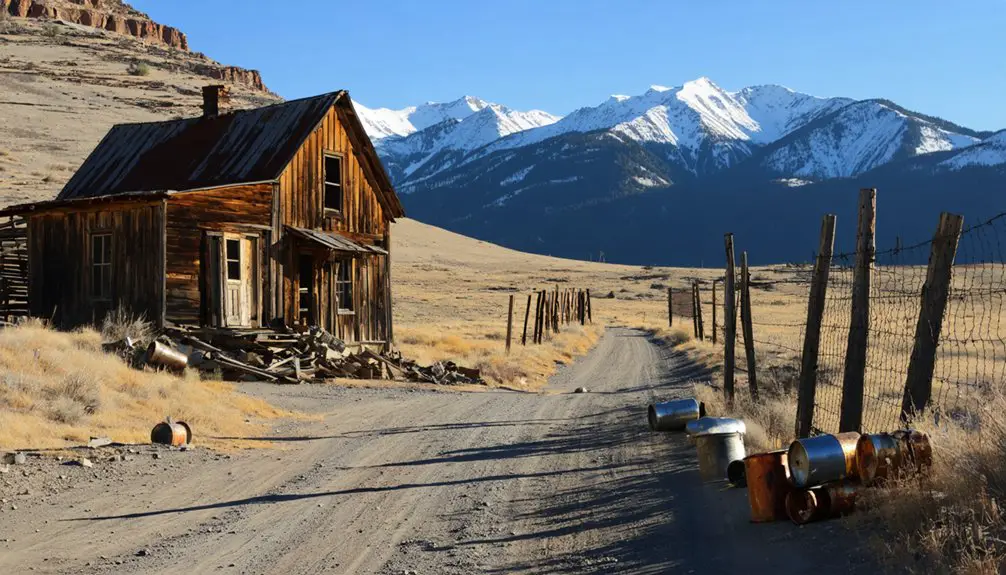You’ll find the former gold mining town of Blewett tucked away in Washington’s Wenatchee Mountains along US Route 97. Originally named Werner in 1893, it flourished after Edward Blewett established extensive mining operations that produced over 850,000 ounces of gold. The bustling community of 300 residents enjoyed saloons, a post office, and weekend dances at Rose Lodge before declining in 1924. A historical marker now stands where this once-notorious mining camp transformed the landscape.
Key Takeaways
- Blewett began as a mining town in Washington state during the 1870s gold rush, named after mining entrepreneur Edward Blewett.
- The town flourished with 200-300 residents, featuring saloons, a boarding house, and Washington’s largest stamp mill operation in 1905.
- Gold production totaled 850,900 ounces between 1870-1959, before declining when the main ore vein was depleted.
- The community’s post office closed in 1924, marking the town’s transition to ghost town status.
- The former town site is commemorated by a historical marker along US Route 97 in Washington state.
From Werner to Blewett: The Story Behind the Name
While the mining town’s original name of Werner appeared on post office records in early 1893, the community quickly adopted the name Blewett to honor Edward Blewett, a Seattle mining entrepreneur whose company controlled much of the area’s gold claims.
As a common English surname, Blewett had deep historical roots that extended well beyond this Washington mining town.
The name change reflected the growing significance of Blewett’s mining operations, which brought prosperity and development to this remote corner of Washington state.
You’ll find that this mining legacy shaped more than just the town’s name. Under Blewett’s leadership, the community transformed from a simple mining camp into a bustling hub with infrastructure including roads, stage routes, and essential services.
A wagon road constructed in 1879 from Cle Elum finally made the area accessible to vehicles rather than just trails.
The name significance carries through to today, where you can spot a historical marker on US Route 97 commemorating the town’s golden era.
Early Gold Discovery and Mining Claims
When prospectors returning from British Columbia’s Fraser River strike discovered placer gold in the Swauk and Peshastin Creek areas in 1858, they sparked a mining rush that would define Blewett’s destiny.
By 1860, around 200-300 miners flocked to Peshastin Creek, where they found rich placer deposits that promised wealth and independence.
The mining settlement quickly gained notoriety as one of the roughest camps in Chelan County.
The early prospectors worked these placer deposits until 1874 when they discovered gold veins in Culver Gulch, shifting their focus to lode mining.
The discovery of gold veins in Culver Gulch marked a pivotal shift from placer mining to more complex lode extraction methods.
Edward Blewett of Seattle soon emerged as a key player, securing numerous claims through his mining company.
The town established a post office in 1893 to serve its growing population of miners and merchants.
The changeover to hard rock mining brought more organized operations, with miners digging test holes and tunnels into mountainsides to access valuable quartz veins containing “free gold,” prized for its exceptional purity.
Life in a Booming Mining Town
If you’d lived in booming Blewett during its heyday, you’d have joined hundreds of miners working grueling shifts tunneling thousands of feet into the hillsides for gold ore, only to emerge exhausted at day’s end.
You might’ve found comfort at one of the town’s two saloons or the boarding house, where miners gathered to unwind and share stories of their latest finds.
The tight-knit community of 200-300 residents supported each other through the telegraph office, general store, and post office, which served as essential hubs for news and supplies in this remote mining settlement.
The opening of the wagon road to Cle Elum in 1879 finally connected the once-isolated mining community to vital trade and supplies from the outside world.
Daily Routines and Work
As gold fever swept through Blewett in the late 1800s, miners endured grueling daily routines that defined life in this bustling Washington mining town.
You’d find them working long shifts deep underground, maneuvering thousands of feet of tunnels while battling hazardous conditions and constant flooding threats. When hard-rock mining replaced early placer operations, your daily tasks would’ve included extracting gold-bearing quartz and hauling ore to the stamp mill for processing. The Meteor Mining Company established Washington’s largest stamp mill operation in 1905.
Beyond the mines, you’d see a flurry of essential support work – blacksmiths forging tools, packers leading supply-laden mules, and mill workers crushing ore that sometimes yielded an astounding 500 ounces of gold per ton.
Despite the challenging work conditions and miner safety concerns, the promise of striking it rich kept the community’s spirit alive.
Social Activities After Dark
Despite long days of backbreaking labor in the mines, Blewett’s residents found vibrant ways to unwind after dark, particularly at the town’s central gathering spot – the saloon.
You’d find miners trading their work boots for town shoes before heading to nighttime festivities at the two-story hotel or nearby Grange Hall.
Saturday nights brought the most excitement, with social gatherings drawing folks to weekend dances at Rose Lodge, where you might spot Finnish girls and local miners riding horseback to join the festivities.
The location’s history as an original wagon road dating back to 1879 made it a natural meeting point for travelers and locals alike at the telegraph station and stores, which buzzed with evening activity as residents shared news and planned upcoming events.
These gatherings often lasted until early Sunday morning, creating a welcome escape from the daily grind and fostering bonds within this diverse frontier community. Among the regulars was Antoine Etienne, who would sometimes trade his fresh peaches for goods at the local trading post.
Community Support Networks
While mining towns often struggled with isolation and scarcity, Blewett’s residents forged robust support networks that kept their community thriving through boom and bust cycles.
You’d find community resilience on display when miners volunteered their labor to maintain vital wagon roads or when neighbors helped repair flood-damaged infrastructure.
The town’s mutual aid system proved indispensable during emergencies, particularly when winter storms or floods cut off supply routes.
You could count on the general store, post office, and telegraph station to serve as information hubs where residents shared resources and news.
Even during the challenging shift from placer to hard-rock mining, the community pulled together, pooling expertise and equipment.
This spirit of cooperation helped Blewett’s residents weather six-week periods of isolation and maintain crucial services despite their remote location.
Transportation and Mail Routes

Before the advent of modern highways, Blewett’s transportation network began with a simple wagon road laid out in 1879 by L.F. Warner, who operated the local mines.
By 1891, miners had expanded this network, connecting Swauk Mining Camp to Peshastin Mining Camp using old Indian trails and clever switchbacks to manage steep terrain.
You’d have found regular stagecoach service running three times weekly between Blewett and Peshastin by 1896, carrying both passengers and mail along the newly completed route.
The network grew further when miners, contributing one week of labor monthly, finished the significant 32-mile wagon road linking Cle Elum to Peshastin by 1898.
This essential artery served as the foundation for the region’s mining activities, with stage stations dotting the route to support travelers and guarantee reliable mail delivery.
The road later became an important thoroughfare when it was designated as State Road #7 in the early 1920s, serving as the main route between Seattle and Spokane.
In 1925, the route gained additional significance when it was incorporated into the Yellowstone Trail, connecting travelers to the famous national park.
Peak Production Years and Economic Impact
You’ll find Blewett’s peak mining production reflected in its impressive total of 850,900 ounces of gold extracted between 1870 and 1959, with the most intensive operations occurring from the 1870s through the 1890s.
The mining wealth transformed this remote location into a bustling community, complete with a hotel, stores, saloon, and telegraph service by the late 19th century.
Edward Blewett’s Seattle-based mining company brought significant investment to the area, though the economic prosperity wouldn’t last beyond 1905 when the main ore vein was depleted.
Gold Production Numbers
Throughout its operational period from 1870 to 1959, the Blewett mining district emerged as a significant gold producer, yielding an impressive 850,900 ounces of gold through both placer and lode mining operations.
Early gold extraction focused heavily on placer mining, which produced approximately 72,000 ounces from 1870 to 1901. The district’s mining techniques evolved as operations shifted toward lode mining, with Chelan County producing over 666,000 ounces of lode and byproduct gold from 1903 to 1959.
The Holden Mine dominated production during the mid-1900s, contributing 514,525 ounces between 1938 and 1951.
You’ll find that early ore averaged $10 per ton in gold value, with the district’s total pre-1901 production valued at $1.5 million during the region’s most prosperous years.
Mining Wealth Distribution
The distribution of mining wealth in Blewett followed patterns common to many Western boom towns, with large mining companies eventually dominating the most profitable claims. You’ll find that wealth inequality grew as individual prospectors sold or bonded their claims to larger operators like the Edward Blewett Gold Mining Company.
While claim ownership initially provided opportunities for individual miners, the most valuable areas near Peshastin Creek and Culver Gulch fell under corporate control.
During peak production years between the 1890s and 1910s, Blewett’s economy thrived with over 300 miners supporting local businesses, hotels, and stage lines.
Though mining profits stimulated some local growth through infrastructure and commerce, most of the wealth flowed out through company shareholders rather than staying in the community, ultimately contributing to the town’s decline.
Local Economic Transformation
Once gold placers were discovered along Peshastin Creek in 1860, Blewett’s transformation into a bustling mining economy accelerated dramatically.
You’ll find the most significant economic shifts occurred after 1874 when miners discovered rich vein deposits in Culver Gulch, sparking extensive development throughout the region.
The community’s resilience showed in its rapid infrastructure growth, as you’d have seen the town flourish with a school, two-story hotel, stores, and telegraph office.
By 1898, a new road to Peshastin improved accessibility, while stagecoach lines running three times weekly connected you to regional commerce.
The district’s peak production years yielded an impressive 850,900 ounces of gold by 1959, though after 1910, operations scaled down to smaller ventures, marking the end of Blewett’s golden age.
The Town’s Slow Decline
After Blewett’s main ore vein ran dry in 1905, this once-bustling mining town began its inevitable descent into abandonment.
Economic factors hit hard as the stamp mill closed and mining output plummeted, forcing miners and their families to seek opportunities elsewhere. You’d have witnessed the town’s population plummet from 300 residents to just a handful as businesses shuttered one by one.
Population shifts accelerated through the 1910s and 1920s, marked by the post office’s closure in 1924.
The town’s notorious reputation as “The Camp” – once alive with saloons and lawlessness – faded into silence.
What Remains Today: Historical Sites and Markers

Despite decades of abandonment, modern visitors to Blewett’s former townsite can still discover significant remnants of its mining heritage.
You’ll find the stone foundation of an old stamp mill standing as a monument to the area’s industrial past, while scattered mining holes and tunnels punctuate the surrounding hillsides.
If you’re exploring US-97, you can’t miss the official historical marker at milepost 174, complete with a convenient parking area.
The marker, listed on the National Register of Historic Places, provides essential context about this once-bustling mining community.
While the original buildings – including the two-story hotel, school, and saloons – have largely vanished, their foundations peek through the landscape, offering glimpses of the town’s layout beneath the modern highway.
Frequently Asked Questions
Were Any Famous Outlaws or Notable Historical Figures Known to Visit Blewett?
Like tumbleweeds in the wind, outlaw legends drift away unsupported. You won’t find documented proof of famous historical visitors to this lawless mining town, beyond Edward Blewett, the Seattle businessman it’s named after.
What Happened to the Families and Children After the Town’s Decline?
You’ll find most families relocated to nearby towns like Cle Elum and Peshastin after 1905, seeking work and children’s education. They followed mining opportunities or switched to agriculture and timber jobs.
How Did Miners Survive the Harsh Winter Conditions in Blewett?
At 2,328 feet elevation, you’d need more than grit to survive. You’d rely on layered wool clothing, communal meals in boarding houses, and stockpiled supplies while keeping mining operations going through snowy conditions.
Were There Any Major Accidents or Disasters in Blewett’s Mining Operations?
While historical accident reports don’t document any major mining disasters in Blewett, you’ll find typical hazards like cave-ins and equipment failures likely occurred during mining operations there, though details weren’t preserved.
Did Native American Tribes Have Any Significant Interactions With Blewett’s Mining Community?
You’d be hard-pressed to find records of significant cultural exchange or trade relations – historical documents show Native Americans established the original trails but largely avoided direct contact with Blewett’s mining operations.
References
- https://en.wikipedia.org/wiki/Blewett
- https://revisitwa.org/waypoint/blewett/
- http://www.ghosttownsusa.com/oblew.htm
- https://westernmininghistory.com/towns/washington/blewett/
- https://kids.kiddle.co/Blewett
- https://explore-wa.com/blewett-historical-marker/
- https://revisitwa.org/waypoint/teanaway/
- https://westernmininghistory.com/library/38197/page1/
- https://sunset-hwy.com/blewett1.htm
- https://dirtyfreehub.org/routes/washington/old-blewett/



